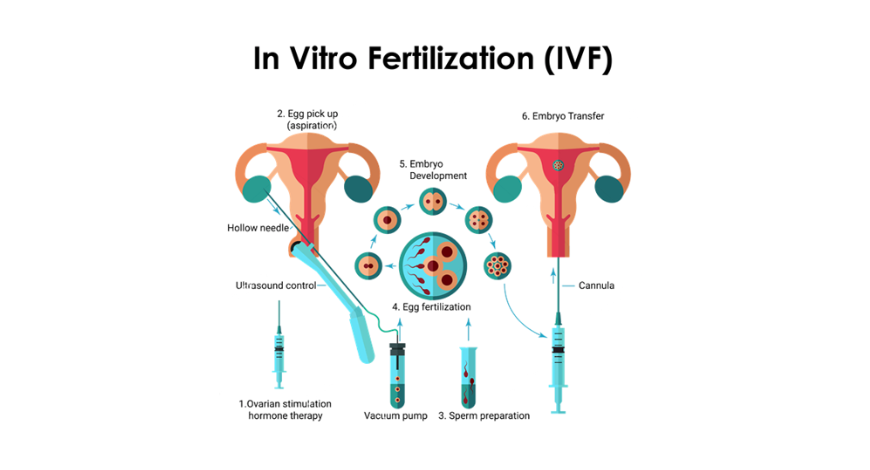During IVF, an egg is removed from the woman’s ovaries and fertilised with sperm in a laboratory.
The fertilised egg, called an embryo, is then returned to the woman’s womb to grow and develop.
It can be carried out using your eggs and your partner’s sperm, or eggs and sperm from donors.
What happens during IVF
IVF involves 6 main stages:
- suppressing your natural cycle – the menstrual cycle is suppressed with medication
- boosting your egg supply – medication is used to encourage the ovaries to produce more eggs than usual
- monitoring your progress and maturing your eggs – an ultrasound scan is carried out to check the development of the eggs, and medication is used to help them mature
- collecting the eggs – a needle is inserted into the ovaries, via the vagina, to remove the eggs
- fertilising the eggs – the eggs are mixed with the sperm for a few days to allow them to be fertilised
- transferring the embryo(s) 1 or 2 fertilised eggs (embryos) are placed into the womb
Chances of success
The success rate of IVF depends on the age of the woman undergoing treatment, as well as the cause of the infertility (if it’s known).
Younger women are more likely to have a successful pregnancy. IVF isn’t usually recommended for women over the age of 42 because the chances of a successful pregnancy are thought to be too low.
Between 2014 and 2016 the percentage of IVF treatments that resulted in a live birth was:
- 29% for women under 35
- 23% for women aged 35 to 37
- 15% for women aged 38 to 39
- 9% for women aged 40 to 42
- 3% for women aged 43 to 44
- 2% for women aged over 44
These figures are for women using their own eggs and their partner’s sperm, using the per embryo transferred measure.
The Human Fertilisation and Embryo Authority (HFEA) has more information on in vitro fertilisation (IVF), including the latest success rates.
Maintaining a healthy weight and avoiding alcohol, smoking and caffeine during treatment may improve your chances of having a baby with IVF.
Understanding the steps of IVF
How is the IVF process done , Step by Step ?
This is to provide you with the basic introductory guide about the most effective infertility treatment.
Here’s how IVF works, step- by- step:
Preparation for an IVF cycle :
- Testing
One cycle before IVF starts (it usually starts from day 2 or day 3 of your period), you will be evaluated. Pre-cycle testing includes
- A pelvic ultrasound for evaluation of uterus
- Hormonal tests to assess thyroid function and ovarian reserve
- Screening both partners for sexually transmitted infections
- Semen analysis of male partner
- Ovarian stimulation
Even if ovulation is normal, fertility drugs are used to produce more eggs because pregnancy rates are higher with more eggs.
Fertility drugs are usually injections taken daily(which are taken by the patient herself) for about 8-14 days.
An average of 10-20 eggs are usually retrieved for IVF.On an average,only about two-thirds have appropriate maturity.
At Medfemme Women’s Clinic- Dr.Tejashri will carefully design a protocol,which is crafted as per the individual need of the patient to obtain the maximum number of eggs while protecting against OHSS.
During the process of taking injection, you will be monitored using hormonal blood tests and vaginal ultrasounds for best results.
Once an ultrasound determines that you have a sufficient number of large follicles and your estrogen is at the right level, you shall receive a trigger shot of HCG or agonist (as per your need) .
This replaces the natural luteinizing hormone surge, a woman has at the final stage of egg maturation.
- Egg Retrieval
34-36 hours after receiving the trigger shot-before the egg ovulate-you’ll have the surgical procedure to remove the eggs from the follicles in your ovaries.
A transvaginal ultrasound is used to visually guide a small needle through the top of the vagina. You don’t experience any pain/discomfort during the process as you’ll be under sedation through an IV cannula. The entire procedure takes less than 30 minutes.
You might feel some minor cramping on day of procedure, next day you will be perfectly fine.
The eggs which are removed are handed over to the embryologist.All the details of the eggs are carefully recorded.
- Fertilization
Mature eggs are transferred into a special culture medium,placed in an incubator and within a few hours of egg retrieval,are fertilized with the sperm.
- Embryo Transfer
IVF team and the couple determine exactly when embryo transfer will take place, usually 3-5 days after egg retrieval.
The number of embryos transferred depends upon the history of couple, reason for IVF,quality and day of embryo, but we usually recommend a single day 5 embryo transfer.This is seen to be the safest and best approach.
The procedure of embryo transfer is done under guidance of an abdominal ultrasound.
- Pregnancy test
After about 12-14 days of embryo transfer,you’ll have a blood pregnancy test.During this time, you will be prescribed about 3-4 medicines.

